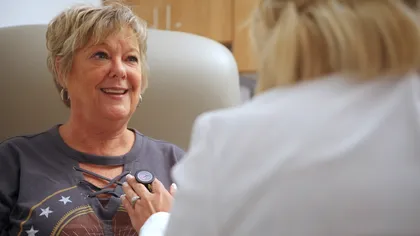Skin Cancer
Skin cancer is a serious disease that can affect anyone at any age. It’s the most common kind of cancer in the U.S. If found early, when it’s small and hasn’t spread, skin cancer can often be treated with success. But in some cases, it’s life-threatening.
Talk with your healthcare provider about what you can do to help prevent skin cancer. Ask about regular skin exams as part of your routine physicals. You can also ask about doing monthly self-exams of your skin. If you see any changes in your skin, call your healthcare provider right away.
Understanding the skin
The skin is made up of 3 layers: epidermis, dermis, and hypodermis or fat layer. The epidermis is the thin outer layer of the skin. It consists of 3 types of cells: squamous cells, basal cells, and melanocytes. The squamous cells are flat cells in the outermost layer and are continuously shed. The basal cells are round cells found just beneath the squamous cells at the base of the epidermis. The melanocytes are found in every layer of the epidermis and make melanin. This give the skin its color. The dermis layer is the middle layer of skin and consists of blood and lymph vessels, hair follicles, oil and sweat glands, nerves and collagen. This layer give skin flexibility and strength. The fat layer is the deepest layer consisting of fat and collagen. It helps provide the body’s heat and protects the body from injury.
Skin cancer is a type of cancer that grows in the epidermal layer of the skin. It can form in the basal cells, squamous cells, or melanocytes. Skin cancer can be grouped into 2 types: non-melanoma and melanoma. The 2 most common types of non-melanoma skin cancer are basal cell carcinoma and squamous cell carcinoma.
Basal cell cancer
Basal cell cancer is the most common skin cancer. It starts in basal cells in the deepest part of the epidermis. It’s usually found on the face, ears, neck, trunk, or arms, but it can start anywhere. Varying in color, these lesions may be waxy, pearly, scaly, or scar-like. Tiny blood vessels can sometimes be seen through the lesion’s surface. These lesions can bleed easily and might not heal well. Nearly all basal cell cancers can be treated and cured.
Squamous cell cancer
Squamous cell cancer is another type of skin cancer. It starts in flat cells called squamous cells in the upper part of the epidermis. Lesions often form on the face, ears, neck, hands, or arms. They can start in scars and sores that don’t heal. The lesions are firm, red bumps or flat, scaly, crusty growths. Squamous cell carcinoma is more likely to grow and spread to other parts of the body than basal cell carcinoma, although this is still uncommon. Most squamous cell carcinoma is found early enough to be treated and cured.
Melanoma
Melanoma is a less common, but much more dangerous kind of skin cancer. It starts in skin cells called melanocytes. It’s more likely to grow and spread than basal or squamous cell cancers. It’s often not easy to tell where a melanoma lesion’s borders are. It’s often brown or black, but it may be mixed in color. The shape and size of melanoma lesions tend to differ from one side to the other. Melanoma can start anywhere, like the genitals, mouth, palms of hands, bottoms of feet, and under the nails.
There are other types of skin cancer, too. These include Merkel cell cancer, Kaposi sarcoma, and skin (cutaneous) lymphomas, but these cancers are quite rare.
Actinic keratosis
Actinic keratosis is not skin cancer. It’s a common, pre-cancer skin change that can turn into a squamous cell skin cancer over time if left untreated. Actinic keratosis lesions tend to appear on sun-exposed parts of the body. They can be pink, reddish-brown, or skin-colored. These lesions are most often small, raised, scaly, and rough, like sandpaper. In some cases, actinic keratosis lesions hurt. Most people with them have more than one lesion. Getting early treatment for actinic keratoses almost always cures the lesions.









